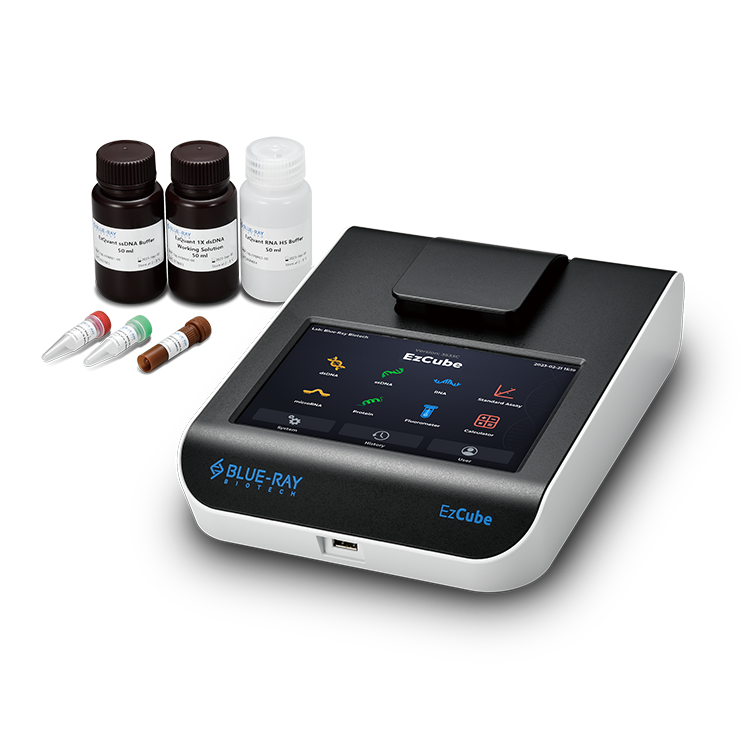Spectrophotometers vs. Fluorometers: Choosing the Right Tool for DNA/RNA Quantification
Sample quantification is crucial for accurate molecular analysis. This guide serves as an aid to researchers who are making a choice between UV-Vis spectrophotometry and fluorometry for nucleic acid quality control.
In molecular biology research, sample quantification is an essential step in evaluation of the suitability of nucleic acid and protein extracts for subsequent applications, such as molecular cloning, next-generation sequencing, or PCR. Two primary quantification techniques are in general use for nuclei acid analysis: UV-Vis spectrophotometry and fluorescence. However, a user might have difficulty in choosing between them. In this guide the functionalities and applications of both techniques are briefly explained and this will help in the choice of the right one.
UV-Vis Spectrophotometry: A Versatile Workhorse for Initial Assessment
Spectrophotometers have been used for the quantification of nucleic acids for a long time and offer versatile and widely applicable methods for the process. The operation hinges on the fundamental principle of light absorption. A spectrophotometer can be used to measure the amount of light absorbed by a sample at a specific wavelength to determine absorbance, a parameter that is directly proportional to the concentration of the absorbing species. This principle, derived from the Beer-Lambert law, provides a powerful tool for the determination of the concentration of substances in a solution.
In the context of nucleic acid quantification, spectrophotometers are particularly useful for assessing DNA purity. Nucleic acids exhibit a characteristic absorption peak at a wavelength of 260 nm, making this wavelength a common reference point for spectrophotometric analysis. However, it is important to note that this method lacks selectivity for nucleic acids, as both DNA and RNA absorb light at 260 nm. This means that spectrophotometry cannot be used to distinguish between pure DNA and samples contaminated with RNA, or any other substances that absorb at the same wavelength.
Fluorometry: Enhanced Sensitivity and Selectivity for Demanding Applications
Fluorometry, as a complementary strategy, offers enhanced sensitivity and selectivity in nucleic acid quantification. The technique utilizes specific reagents known as fluorescent dyes. These dyes specifically bind to nucleic acid molecules and emit light at distinct wavelengths when excited by an external light source. Measurement of the intensity of this emitted light (fluorescence) allows an accurate quantification of nucleic acid concentration, even at extremely low levels.
Fluorometers offer several advantages over spectrophotometers. Firstly, their ability to distinguish between different types of nucleic acids, such as single-stranded DNA (ssDNA) or double-stranded DNA (dsDNA), makes them particularly valuable for applications where sample composition is crucial. Additionally, fluorometers can detect nucleic acid concentrations at the picogram (pg) level, far surpassing the nanogram (ng) range of spectrophotometers.
Choosing the Right Instrument: A Matter of Sample Characteristics
The choice between spectrophotometers and fluorometers for nucleic acid quantification ultimately depends on the characteristics of the sample and the specific requirements of the downstream experiment. For pure homogeneous nucleic acid samples within the nanogram range, or when nucleic acid type differentiation is not needed, spectrophotometers provide a simple and cost-effective solution.
In contrast, fluorometers are ideal for low-concentration samples (picogram range), heterogeneous samples, and when nucleic acid type differentiation is required. Fluorometers offer enhanced sensitivity and selectivity, but the use of a fluorescent dye is a more complicated procedure and takes longer. Additionally, fluorometers generally have a higher upfront cost than spectrophotometers.
Making the choice between a Spectrophotometer and a Fluorometer
|
Criteria |
||
|
Sample concentration (ng) |
★ |
|
|
Sample concentration (pg) |
|
★ |
|
Rapid sample measurement |
★ |
|
|
Selectivity (distinguishing between DNA and RNA) |
|
★ |
|
Complexity and cost of downstream analysis |
|
★ |
Blue-Ray Biotech: A Duet of Detection Techniques
While UV-Vis spectrophotometry and fluorescence techniques differ significantly, the EzDrop Spectrophotometer and EzCube Fluorometer from Blue-Ray Biotech offer distinct yet complementary sample quantification methods.
EzDrop Spectrophotometer: This instrument enables rapid and accurate absorbance-based quantification of purified samples, including nucleic acids and proteins. It boasts a wide detection range for dsDNA concentrations from 2 to 20000 ng/µL and protein concentration (e.g. BSA: 0.06-600 mg/mL).

EzDrop 1000C Micro-Volume / Cuvette Spectrophotometer
EzCube Fluorometer: This instrument excels in the identification of specific types of nucleic acids, including ssDNA, dsDNA, and RNA. It achieves a low detection limit of 0.01 ng/µl (10 pg/µl) for dsDNA, 0.05 ng/µl (50 pg/µl) for ssDNA, and 0.25 ng/µl (250 pg/µl) for RNA, using specific paired reagents tailored for different sample types. Additionally, EzCube Fluorometer has three LED light sources that excite various fluorescence reagents, enabling it to address specific applications such as NGS, qPCR, cloning, and transfection.

Choosing the EzDrop Spectrophotometer and EzCube Fluorometer that fits your Needs
|
Category |
Spectrophotometer |
Fluorometer |
|
Model |
EzDrop 1000 and 1000C Micro-Volume Spectrophotometer |
|
|
Technique |
UV-Vis Spectrophotometry |
Fluorescence |
|
Advantage |
|
|
|
Detection Range |
dsDNA: 2 - 20000 ng/µL; BSA: 0.06- 600 mg/mL |
dsDNA: 0.01 - 100 ng/µl ssDNA: 0.05 - 200 ng/µl RNA: 0.25 - 100 ng/µl |
Conclusion: Leveraging Complementary Strengths
Blue-Ray Biotech's EzDrop Spectrophotometer and EzCube Fluorometer provide distinct yet complementary quantification methods. The EzDrop Spectrophotometer allows rapid and accurate absorbance-based quantification, while the EzCube Fluorometer excels in identifying specific nucleic acid types with low detection limits. Leveraging their complementary strengths, researchers can effectively quantify a wide range of samples and identify samples with diverse properties, ultimately facilitating successful downstream experiments.
Learn More About EzCube Fluorometer
Learn More About EzDrop 1000 Micro-Volume UV/Vis Spectrophotometer